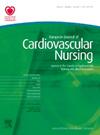Rural dyadic collaboration in heart failure
IF 3.9
3区 医学
Q2 CARDIAC & CARDIOVASCULAR SYSTEMS
引用次数: 0
Abstract
Background Dyads (patient/care partner) living with heart failure have shared responsibility for patient care. While theoretical and empirical literature regarding heart failure dyadic care is evolving rapidly, sociocultural contexts are unique and affect relationship dynamics. Yet, dynamics and underlying structures of rural dyadic collaboration in heart failure remains unknown. Purpose The purpose of this secondary analysis was to describe the dynamics and underlying structures of dyadic collaboration in heart failure among rural dyads. Methods A semi-structured interview was used to evaluate the acceptability and usefulness of a 12-week problem-solving intervention in addressing dyadic heart failure-related issues and the development of effective management strategies in week 5. Initially, in the qualitative analysis, an adjusted matrix analysis for each rural dyad was used to identify these dyadic issues and strategies. Subsequently, dynamics and underlying structures of collaboration occurring within these dyads in addressing these issues and strategies were analyzed and thematic codes generated. Finally, a multiple correspondence analysis of dyadic collaboration was performed within these thematic codes and a Benzécri equation used to normalize results, helping to determine the underlying structure and variance explained by the model on a Cartesian graph. Results Twenty-eight living in the rural southeastern U.S. were included. Patients were mostly Caucasian (73.3%), female (60%), married (70%), and college-educated (43%), with an average age of 67.7 years. Care partners were primarily women (n = 50%), Caucasian (82.1%), married (89.3%), and high school-educated (46.4%), with an average age of 64.5 years. Using inductive coding, four codes emerged regarding dyadic relational and collaborative aspects between dyads: role awareness, requesting or receiving help, and improving dyadic communication. XLStat was used for a multiple correspondence analysis (Fig. 1), with checking and then normalizing results using the Benzécri equation on R (Fig.2). There were two gender-determined patterns within dyads. In dyads in which the patient was female and the care partner male, communication improved, requests for assistance were verbalized, and there was an improvement in collaborative orientation. However, partners were unaware of their collaborative role. In contrast, when the care partner was a woman and the patient a man, communication and requests for help were implied, and there was no improvement in collaborative orientation. In this situation, partners had full role awareness. Conclusion(s) These findings suggest gender constitutes a key element in communication, verbalization of needs, and collaborative orientation within rural dyads living with heart failure. The importance of gender roles may be useful in designing future dyadic interventions for rural individuals with heart failure and their informal care partners.心力衰竭的农村双向协作
背景心力衰竭患者(患者/护理伙伴)共同承担着护理患者的责任。虽然有关心力衰竭双人护理的理论和实证文献发展迅速,但社会文化背景是独特的,会影响关系的动态发展。然而,农村心力衰竭双人协作的动态和潜在结构仍不为人知。目的 本二次分析的目的是描述农村心力衰竭二元合作的动态和潜在结构。方法 采用半结构式访谈,评估为期 12 周的问题解决干预在解决与心衰相关的问题以及在第 5 周制定有效管理策略方面的可接受性和实用性。首先,在定性分析中,对每个农村二人组进行了调整矩阵分析,以确定这些二人组问题和策略。随后,分析了这些二元组在解决这些问题和策略时的动态和潜在合作结构,并生成了主题代码。最后,在这些主题代码中对二元合作进行多重对应分析,并使用 Benzécri 等式对结果进行归一化,以帮助确定笛卡尔图上模型所解释的基本结构和方差。结果 28 名居住在美国东南部农村地区的患者被纳入研究。患者大多为白种人(73.3%),女性(60%),已婚(70%),受过大学教育(43%),平均年龄为 67.7 岁。护理伙伴主要为女性(n = 50%)、白种人(82.1%)、已婚(89.3%)、高中学历(46.4%),平均年龄为 64.5 岁。通过归纳编码,得出了四种有关二人关系和二人间合作方面的编码:角色意识、请求或接受帮助以及改善二人沟通。我们使用 XLStat 进行了多重对应分析(图 1),并使用 R 的 Benzécri 公式对结果进行了检查和归一化(图 2)。在双人组中有两种性别决定的模式。在患者为女性、护理伙伴为男性的二人组中,沟通得到了改善,求助得到了口头表达,合作导向也得到了改善。然而,护理伙伴并没有意识到自己的合作角色。相反,如果护理伙伴是女性,患者是男性,那么沟通和求助都是默示的,合作导向没有改善。在这种情况下,护理伙伴具有充分的角色意识。结论 这些研究结果表明,在患有心力衰竭的农村二人组中,性别是沟通、口头表达需求和合作取向的关键因素。性别角色的重要性可能有助于为农村心力衰竭患者及其非正规护理伙伴设计未来的双向干预措施。
本文章由计算机程序翻译,如有差异,请以英文原文为准。
求助全文
约1分钟内获得全文
求助全文
来源期刊

European Journal of Cardiovascular Nursing
CARDIAC & CARDIOVASCULAR SYSTEMS-NURSING
CiteScore
5.10
自引率
10.30%
发文量
247
审稿时长
6-12 weeks
期刊介绍:
The peer-reviewed journal of the European Society of Cardiology’s Council on Cardiovascular Nursing and Allied Professions (CCNAP) covering the broad field of cardiovascular nursing including chronic and acute care, cardiac rehabilitation, primary and secondary prevention, heart failure, acute coronary syndromes, interventional cardiology, cardiac care, and vascular nursing.
 求助内容:
求助内容: 应助结果提醒方式:
应助结果提醒方式:


